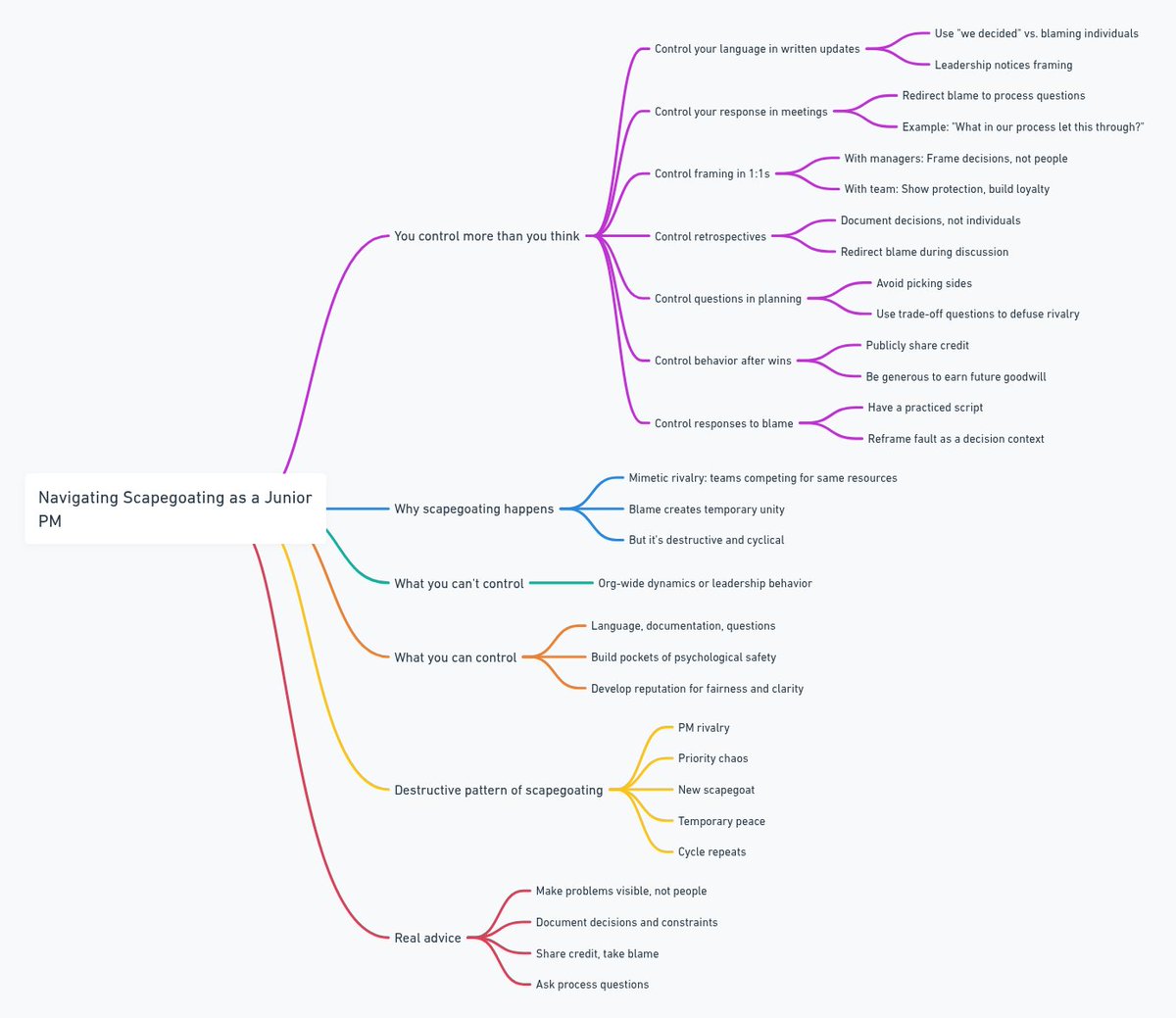Stop doing these 'best practices' in as a Product Manager:
- Backlog grooming
- Writing JIRA tickets
- Leading stand-ups
- Playing scrum master
A thread on what to do instead (from someone who learned the hard way) 🎞️
- Backlog grooming
- Writing JIRA tickets
- Leading stand-ups
- Playing scrum master
A thread on what to do instead (from someone who learned the hard way) 🎞️
1/ Stop running the daily standup
"But who'll run it if I don't?"
Startup: Your tech lead/senior eng
BigCo: Team lead/EM
Why? Every minute you spend running process is a minute not spent on:
- Finding highest-impact problems
- Aligning stakeholders on vision
- Uncovering hidden assumptions
Leaders: Coach PMs to attend but not lead.
"But who'll run it if I don't?"
Startup: Your tech lead/senior eng
BigCo: Team lead/EM
Why? Every minute you spend running process is a minute not spent on:
- Finding highest-impact problems
- Aligning stakeholders on vision
- Uncovering hidden assumptions
Leaders: Coach PMs to attend but not lead.
2/ Stop being the team's secretary
Common trap: Becoming the human JIRA
- Taking all the notes
- Updating all the tickets
- Chasing every status
Startup: Let engineers own their tasks
BigCo: That's what delivery managers are for
Leaders: If your PM is doing this, your org has unclear roles.
Common trap: Becoming the human JIRA
- Taking all the notes
- Updating all the tickets
- Chasing every status
Startup: Let engineers own their tasks
BigCo: That's what delivery managers are for
Leaders: If your PM is doing this, your org has unclear roles.
3/ Stop playing project manager
"But things won't ship on time!"
Startup: Time box efforts, not outcomes. Let tech lead manage capacity
BigCo: Partner with your TPM, don't compete with them
The moment you own the timeline, you lose the ability to negotiate scope.
Leaders: Clear ownership prevents double work.
"But things won't ship on time!"
Startup: Time box efforts, not outcomes. Let tech lead manage capacity
BigCo: Partner with your TPM, don't compete with them
The moment you own the timeline, you lose the ability to negotiate scope.
Leaders: Clear ownership prevents double work.
4/ Stop being the requirements police
"But they'll build the wrong thing!"
Wrong approach: Detailed specs + heavy process
Right approach: Clear outcomes + guard rails
Startup:
- One-pager with clear success metrics
- Weekly team working sessions
- Rapid prototypes and feedback
- Document decisions, not specifications
BigCo:
- Focus on the "why" and business case
- Get sign-off on outcomes, not features
- Keep technical specs as appendix
- Document key trade-offs and decisions
Leaders: Measure outcomes, not requirement compliance.
"But they'll build the wrong thing!"
Wrong approach: Detailed specs + heavy process
Right approach: Clear outcomes + guard rails
Startup:
- One-pager with clear success metrics
- Weekly team working sessions
- Rapid prototypes and feedback
- Document decisions, not specifications
BigCo:
- Focus on the "why" and business case
- Get sign-off on outcomes, not features
- Keep technical specs as appendix
- Document key trade-offs and decisions
Leaders: Measure outcomes, not requirement compliance.
5/ Stop being the backlog janitor
"Someone needs to groom the backlog!"
Startup: Delete it. Start fresh. What matters now?
BigCo: Archive old tickets quarterly. Keep only next quarter visible.
Your job isn't managing tickets.
Your job is managing value creation.
Leaders: Large backlogs = unclear strategy.
"Someone needs to groom the backlog!"
Startup: Delete it. Start fresh. What matters now?
BigCo: Archive old tickets quarterly. Keep only next quarter visible.
Your job isn't managing tickets.
Your job is managing value creation.
Leaders: Large backlogs = unclear strategy.
6/ "But my team expects me to do all this!"
Startup: Have the hard conversation about role clarity
BigCo: Get your manager involved in resetting expectations
Script:
"I've been doing X, but it's preventing me from focusing on Y, which delivers more value because Z"
Leaders: Back your PMs in these conversations.
Startup: Have the hard conversation about role clarity
BigCo: Get your manager involved in resetting expectations
Script:
"I've been doing X, but it's preventing me from focusing on Y, which delivers more value because Z"
Leaders: Back your PMs in these conversations.
7/ What to do instead:
Startup PMs:
- Own strategy, not tickets
- Focus on weekly customer learning
- Partner with tech lead on trade-offs
- Keep process minimal
BigCo PMs:
- Build stakeholder coalition
- Focus on quarterly outcomes
- Partner with TPM/EM roles
- Document key decisions
Startup PMs:
- Own strategy, not tickets
- Focus on weekly customer learning
- Partner with tech lead on trade-offs
- Keep process minimal
BigCo PMs:
- Build stakeholder coalition
- Focus on quarterly outcomes
- Partner with TPM/EM roles
- Document key decisions
8/ For PM Leaders:
Your PMs fall into these traps because:
- Role confusion
- Unclear expectations
- Wrong incentives
- Fear of losing control
Fix the system, don't blame the PM.
Your PMs fall into these traps because:
- Role confusion
- Unclear expectations
- Wrong incentives
- Fear of losing control
Fix the system, don't blame the PM.
9/ Reality check:
Doing "product owner" work feels safe
- Clear deliverables
- Visible progress
- Team happiness
But it's a career trap.
Doing "product owner" work feels safe
- Clear deliverables
- Visible progress
- Team happiness
But it's a career trap.
Real PM work feels uncomfortable:
- Ambiguous problems
- Uncertain outcomes
- Hard trade-offs
That's how you know you're doing it right.
Follow @nurijanian for more PM reality checks 🤘🏼
- Ambiguous problems
- Uncertain outcomes
- Hard trade-offs
That's how you know you're doing it right.
Follow @nurijanian for more PM reality checks 🤘🏼
• • •
Missing some Tweet in this thread? You can try to
force a refresh






